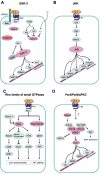Wnt signaling and neurite outgrowth: insights and questions
- PMID: 17627619
- PMCID: PMC11159174
- DOI: 10.1111/j.1349-7006.2007.00536.x
Wnt signaling and neurite outgrowth: insights and questions
Abstract
Wnt signaling consists of a highly conserved set of biochemical pathways that have a multitude of functions during embryonic development and in the adult. The Wnt proteins are extracellular agents that often act as gradient morphogens, indicating that their distribution in tissues is tightly controlled. This attribute is also characteristic of factors that regulate neurite outgrowth and guide axons precisely to their specific destinations. Several studies in various species now have established that Wnts and their receptors have an important role in axonal guidance. Different ligand/receptor combinations have been identified that mediate this activity in many of the experimental models. Clues about downstream effector molecules have come from in vitro systems. In this article, the authors review the results from many of these models, evaluate what is known about the associated signaling pathways and speculate about the direction of future research.
Figures



References
-
- Hausmann G, Banziger C, Basler K. Helping Wingless take flight: how WNT proteins are secreted. Nat Rev Mol Cell Biol 2007; 8: 331–6. - PubMed
-
- Hall AC, Lucas FR, Salinas PC. Axonal remodeling and synaptic differentiation in the cerebellum is regulated by WNT‐7a signaling. Cell 2000; 100: 525–35. - PubMed
-
- Bovolenta P, Rodriguez J, Esteve P. Frizzled/RYK mediated signalling in axon guidance. Development 2006; 133: 4399–408. - PubMed
Publication types
MeSH terms
Substances
Grants and funding
LinkOut - more resources
Full Text Sources
Molecular Biology Databases

